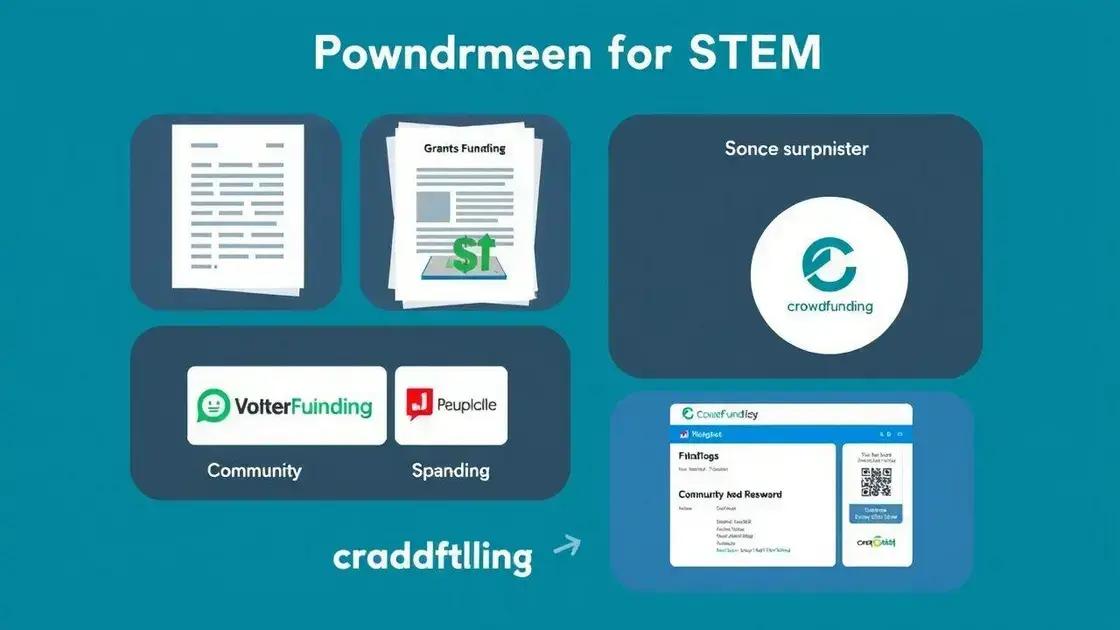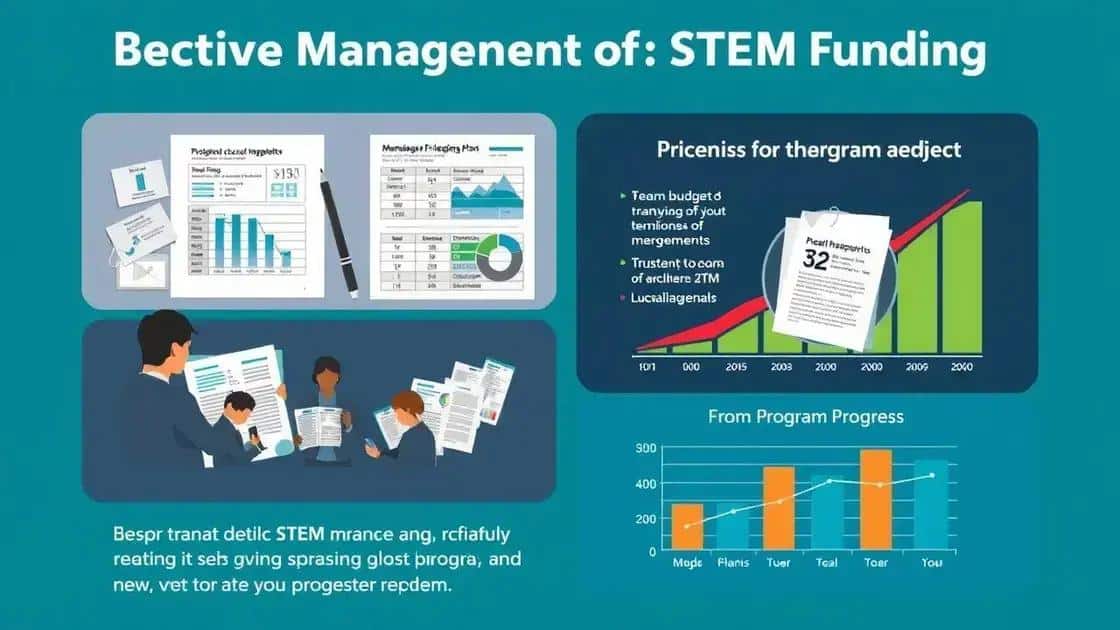Insights on stem program funding: what you need to know

Effective management of stem funding involves creating detailed budgets, monitoring expenses, ensuring transparency, and regularly evaluating program outcomes to maximize resource impact on educational initiatives.
Insights on stem program funding can open new doors for educational institutions aiming to enhance their science and technology curricula. Have you ever wondered how schools secure the necessary resources to foster innovation in STEM fields? Let’s delve deeper into this vital topic.
Understanding stem programs and their importance
Understanding stem programs is essential for fostering curiosity and knowledge in science, technology, engineering, and mathematics. These programs play a vital role in shaping future leaders and innovators.
They are designed to engage students through hands-on learning experiences that spark interest in these critical fields. Schools that implement stem initiatives create opportunities for collaboration, creativity, and real-world problem-solving.
Why are stem programs important?
First and foremost, stem programs address the growing need for skilled workers in a technology-driven job market. This ensures that students are prepared for the future. Additionally, they promote critical thinking and teamwork skills that are invaluable in any career.
Another significant advantage is that stem education encourages underrepresented groups to explore these fields. By nurturing talent from diverse backgrounds, we can cultivate a more inclusive and innovative workforce.
Key benefits of stem programs
- Enhances problem-solving abilities.
- Increases engagement in learning.
- Prepares students for careers in high-demand fields.
- Encourages creativity and innovation.
Moreover, schools with strong stem initiatives often see improved academic performance across subjects. This holistic approach to education can lead to a greater interest in lifelong learning. When students see the direct application of their studies, they become more motivated.
Ultimately, understanding stem programs lays the groundwork for future generations to thrive in an ever-evolving world. These programs not only build knowledge but also essential skills that will benefit students throughout their lives.
Types of funding available for stem initiatives

When exploring types of funding available for stem initiatives, it’s essential to recognize the various sources that can support educational programs. From government grants to private investments, diverse funding options are accessible to schools and organizations seeking to enhance their stem education.
Many schools benefit significantly from federal and state grants. These funds are often designed to boost science and technology programs, helping institutions develop innovative curricula. Local governments may also offer initiatives aimed at improving educational equity, which can include funding for stem programs.
Types of funding sources
- Government Grants: State and federal grants provide essential financial resources.
- Private Donations: Gifts from individuals and alumni can have a substantial impact.
- Corporate Sponsorships: Many companies invest in education for community support and workforce development.
- Nonprofit Organizations: Foundations often offer grants specifically for stem projects.
In addition to these sources, schools can tap into crowdfunding platforms. These platforms allow educators to raise funds directly from the community. It’s a powerful way to engage parents and local businesses in supporting stem education.
Another notable funding avenue is partnerships with universities. Collaborating with higher education institutions can provide valuable resources and expertise, enriching the educational experience for students.
Finally, competitions and challenges can also serve as a source of funding. Many organizations host contests that offer financial awards for innovative stem projects. These opportunities not only provide funding but also foster creativity and enthusiasm among students.
How to apply for stem program funding successfully
Applying for stem program funding successfully involves several important steps. Understanding the process can make a significant difference in securing the financial support needed to enhance educational initiatives. Knowing how and where to apply is crucial for success.
First, identify the specific funding sources that align with your stem initiatives. Research individual grants and their requirements. Pay close attention to the eligibility criteria, deadlines, and application procedures. Each funding organization may have different guidelines, making it essential to tailor your approach.
Key steps in the application process
- Develop a clear proposal: Outline your project’s goals and objectives clearly.
- Provide supporting data: Use statistics and previous results to back up your funding need.
- Engage stakeholders: Ensure community and school support, showing commitment.
- Follow instructions: Adhere strictly to the application guidelines provided by funders.
Next, crafting a compelling narrative in your proposal is vital. Make sure to describe how your stem program meets the funding objectives. Clearly illustrate the impact your project will have on students and the community. Use specific examples to highlight potential outcomes and benefits.
Once your proposal is prepared, review it for clarity and completeness. It’s often helpful to have colleagues or mentors provide feedback. They can offer insights and suggestions that might strengthen your application.
Lastly, be proactive in following up after submitting your application. Many organizations appreciate when applicants take the time to check in. This approach can set you apart and shows your commitment to the program.
Best practices for managing stem funding effectively

Managing stem funding effectively is crucial for maximizing the impact of financial resources on educational initiatives. By following best practices, organizations can ensure that they make the most of available funds and achieve their program goals.
First, create a detailed budget that outlines all expected expenses. This budget should cover materials, equipment, staffing, and any other costs associated with your stem program. Accurate budgeting helps in tracking spending and ensuring that funds are allocated appropriately.
Key strategies for managing funding
- Monitor spending: Keep careful records of all expenditures related to the program.
- Regular reporting: Provide updates to stakeholders on how funds are being used and the progress of the program.
- Adjust as needed: Be flexible in reallocating funds based on project needs and unforeseen circumstances.
- Engage stakeholders: Involve community members and educators in discussions about funding usage.
In addition to these strategies, transparency is critical in managing funding. Make financial reports accessible to stakeholders, which builds trust and accountability. This practice can foster ongoing support for your stem initiatives.
Another important aspect is to periodically evaluate the effectiveness of your stem programs. Assess whether the funding is yielding the desired outcomes and make necessary adjustments to improve performance. Gathering feedback from participants can provide insights into areas for improvement.
Finally, ensure that all staff involved in the program are trained in financial management practices. This training can help to promote a culture of accountability and efficient use of resources throughout the organization.
FAQ – Frequently Asked Questions about STEM Program Funding
What are the main types of funding available for STEM programs?
The main types of funding include government grants, private donations, corporate sponsorships, and nonprofit organization grants.
How can I write a successful proposal for STEM funding?
A successful proposal should clearly outline the project goals, provide supporting data, and demonstrate the potential impact on the community.
What should I do to manage STEM funding effectively?
To manage funding effectively, create a detailed budget, monitor spending, maintain transparency, and regularly evaluate program outcomes.
How can stakeholders support STEM funding initiatives?
Stakeholders can support by participating in discussions, providing feedback, and helping to raise awareness about the importance of STEM education.






